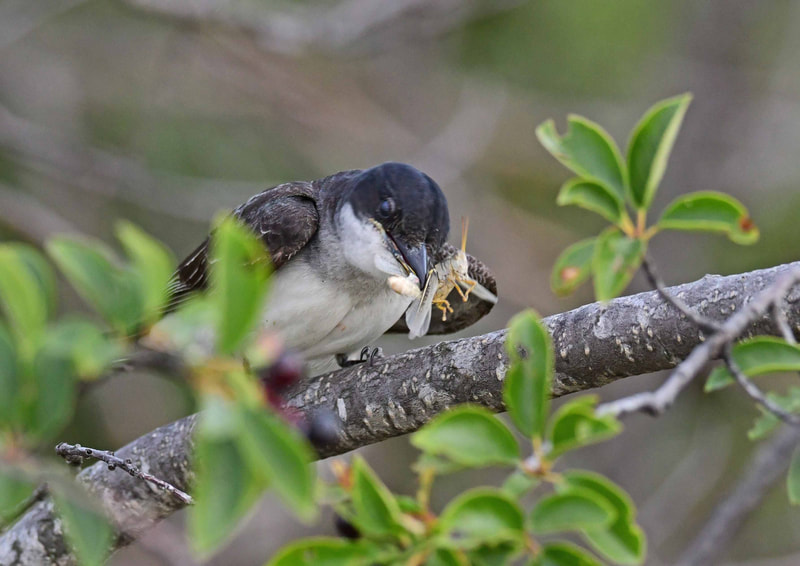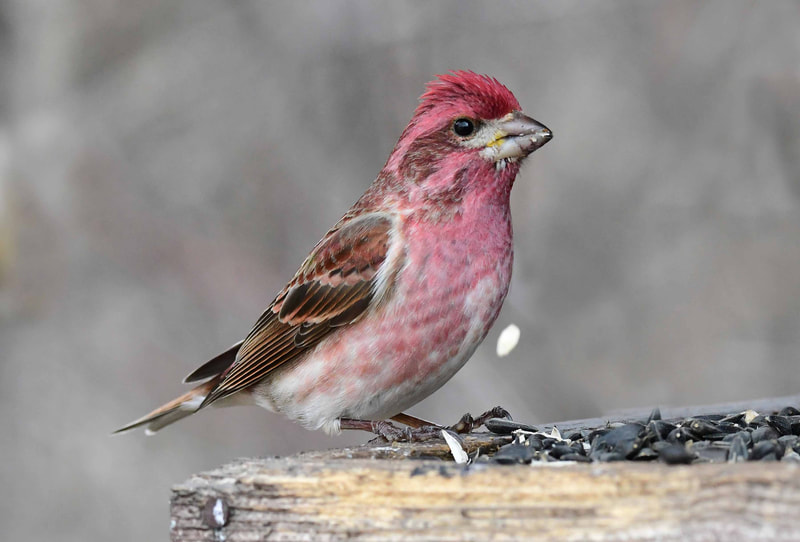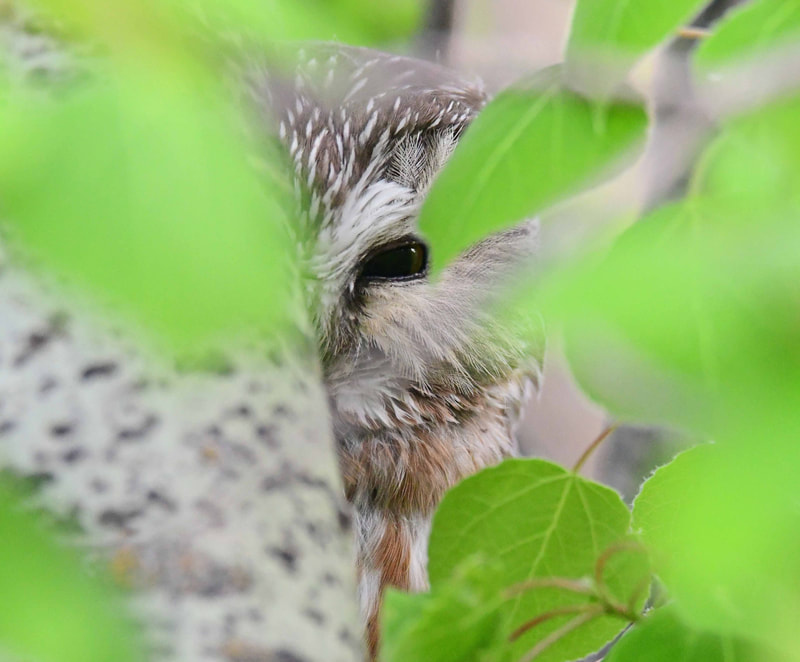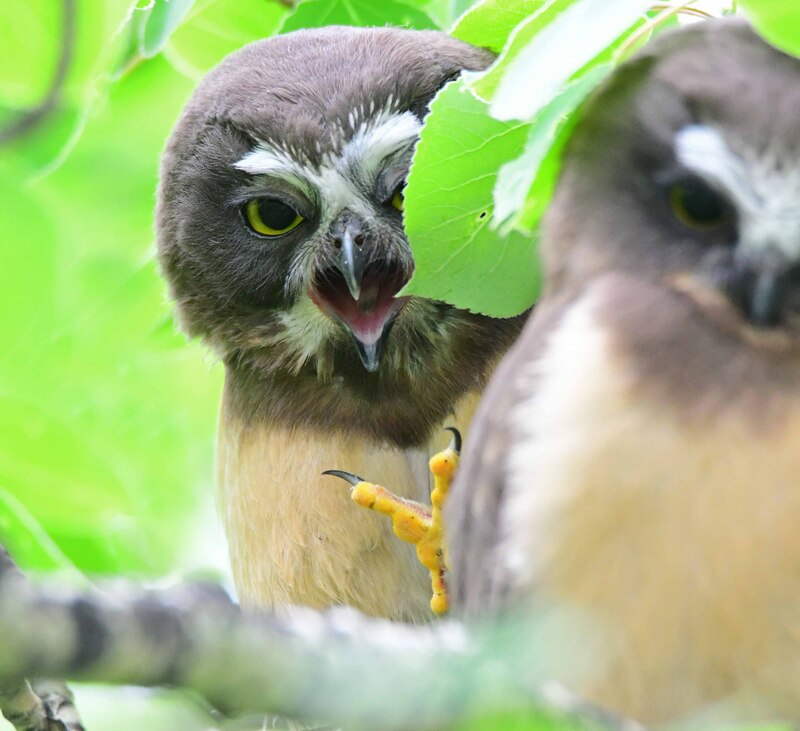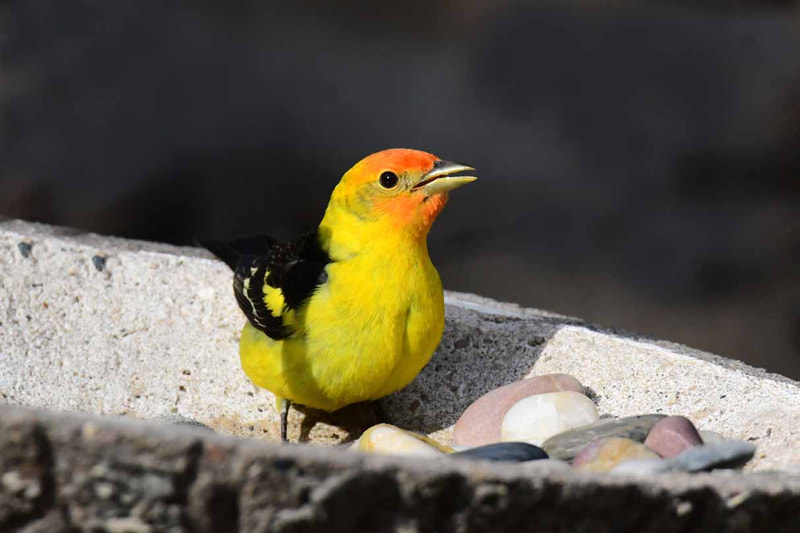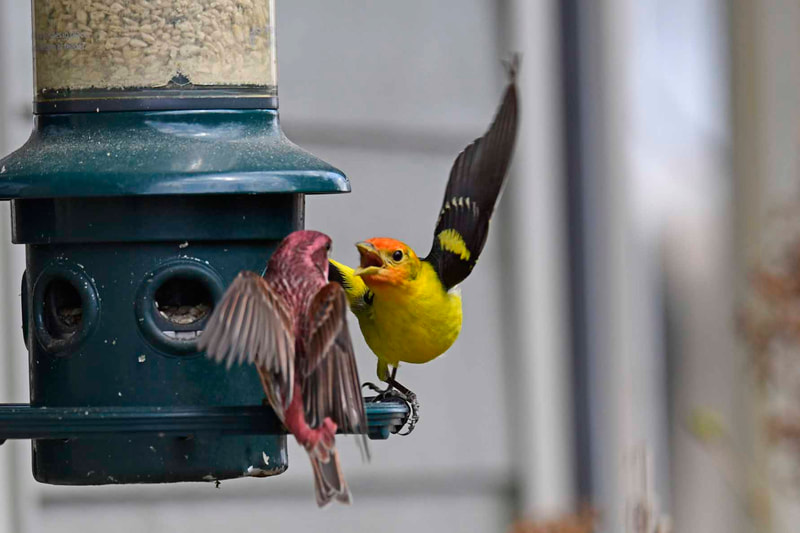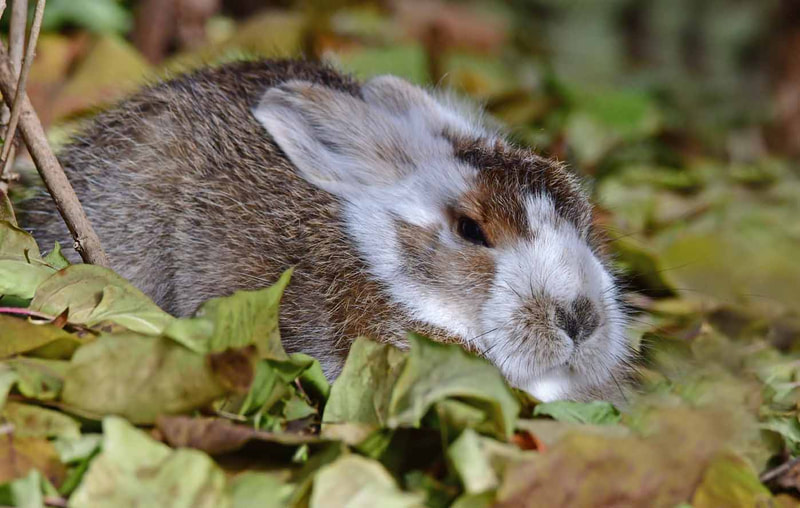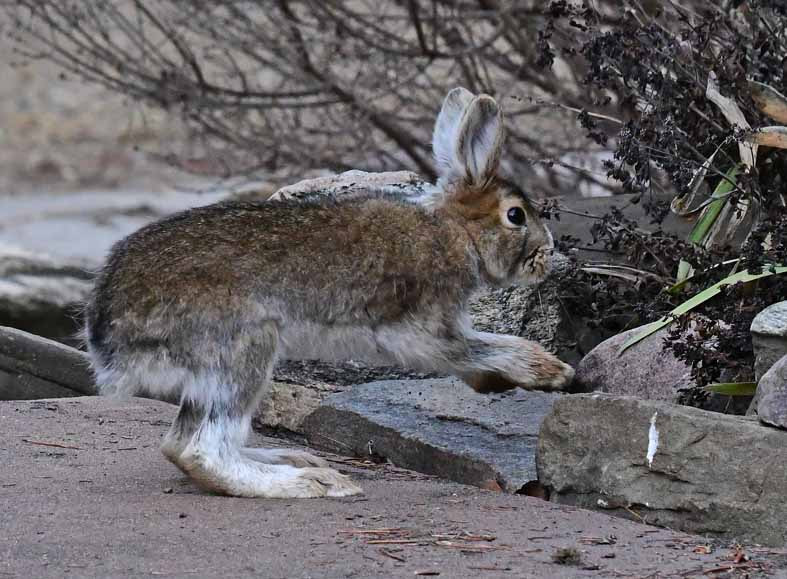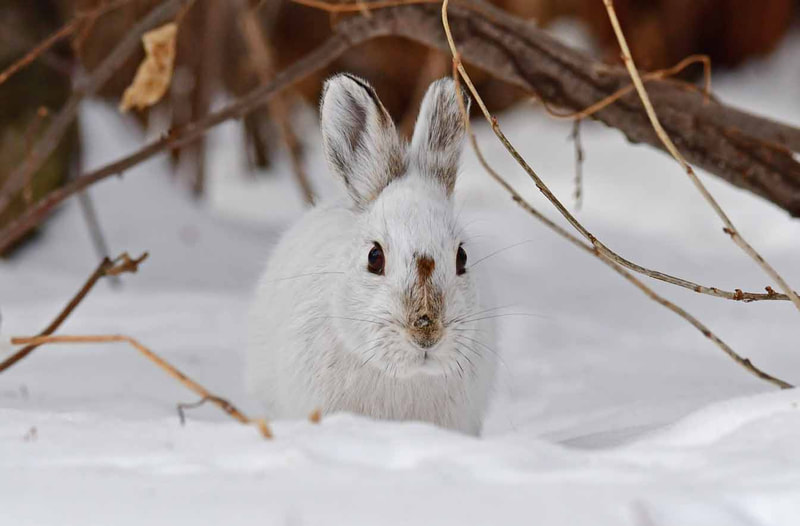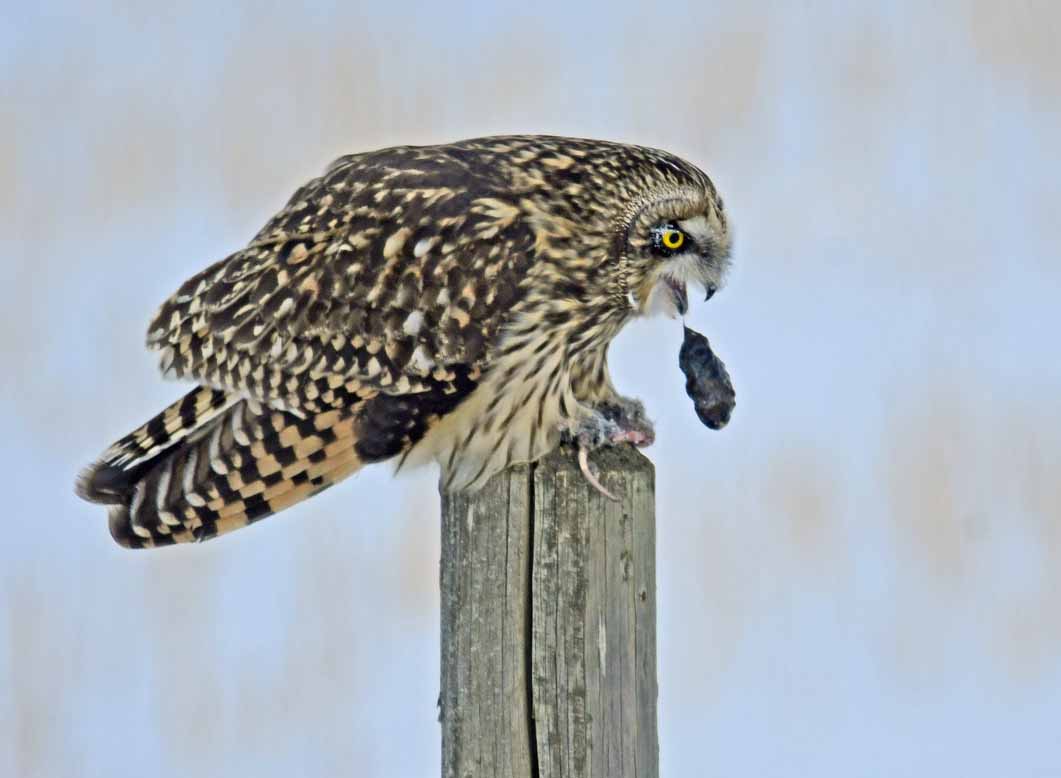Red Deer Advocate-2020
November 28: The Circle of Life at My Bird Feeders
Bird feeding stations are a microcosm of our wider environment, outdoor theatres where real-life nature dramas can be observed and experienced. I have watched many circle-of-life events unfold at and around my feeding stations, including courtship, territorial battles, the feeding and tutoring of newly fledged young, competition for food between and among species, depredation and – during the harsh winter months – a life and death struggle against the elements.

House Finch: House Finches have a long nesting season, and the males will feed the females during courtship. Both adults will also feed their newly fledged young. I watched with interest last summer as a male House Finch gorged on sunflower chips, then hurried up to a nearby branch to regurgitate lunch to another individual. I am not sure whether the recipient of his largess was his offspring or his mate.

Purple Finch: It is always heartening to see young birds, which confirm breeding success and thus another generation of avian neighbours. It was a treat to see this juvenile Purple Finch last summer (note the yellow beak gape and tufts of downy feathers on its crown) dining at the seed feeder.

Pine Siskins: Pine Siskins spend their entire lives in the company of their kith and kin. But that doesn’t mean that they all get along. Bird feeding stations, which concentrate a food source in a limited area, are often scenes of intense scrapping as individuals vie with each other for the right to dine.

Sharp-shinned Hawk: It is always poignant when a predator bird comes screaming into the neighbourhood and grabs a feeder bird for dinner. One day last fall, I watched (with some sadness, I must admit) this Sharp-shinned Hawk ripping apart one of “my” chickadees. But the vitality of all ecosystems depends on healthy predator-prey relationships. The hawks need to eat too.
October 2020: Rusty Blackbirds

When I was the Central Alberta Regional Coordinator for the Alberta Breeding Bird Atlas (ABBA) between 1987-1991, I spent much of my spare time birding in the foothills. It was while doing an ABBA survey south of Rocky Mountain House that I saw my first pair of Rusty Blackbirds. Every spring and fall since that first sighting, my searches for them have been in vain.
Finally, last fall, my luck changed. My first sightings came in September, when we were looking for Whooping Cranes north of Saskatoon. There, flitting along the edge of a small wetland, we saw them! And then we saw more, and more. Almost every small bush-lined pothole seemed to be alive with Rusty Blackbirds moving south on migration. They were sometimes seen in single flocks and sometimes in the company of Red-winged Blackbirds.
Last winter, some friends near Empress, SK had one overwinter in their yard, eating sunflower seeds. Luckily, this individual was both vocal (so I got to listen to its unique chattering) and tame (so I was able to get some photos).
Male Rusty Blackbirds in breeding plumage are a dark glossy black with light eyes, resembling small Common Grackles. The females are brownish to rusty colored with yellow eyes and a pale eyebrow. In the winter, both sexes are very distinctive, as their winter plumage is a unique rusty bronze (although their name is based on their call, which sounds like a rusty door hinge).
Rusty Blackbirds breed in wet forests, bogs, muskegs and beaver ponds across the boreal forests of the continent. In Central Alberta, they are most commonly seen moving through on spring and fall migration. Some occasionally overwinter (there were reports of a small flock in Clive last winter) but they have never been recorded on a Central Alberta Christmas Bird Count.
Sadly, Rusty Blackbird populations have undergone one of the sharpest and most mystifying declines (on both their breeding and wintering grounds) of any North American songbird. Breeding Bird Surveys estimate that their numbers have dropped by 89% since 1966! So concerned are scientists about this precipitous decline that a Rusty Blackbird Working Group (rustyblackbird.org) has been formed. The loss of wooded wetland habitat is likely the main cause, especially the southeastern U.S. where about 80% of the population overwinters. The historical removal of beavers (and with them the loss of necessary wetland breeding habitat) and high mercury contamination are also possible contributing factors.
I encourage everyone to pay close attention to any blackbirds seen in Central Alberta during the spring and fall migration, and especially during the winter. If you see a Rusty Blackbird (do an online search for ID features if you don’t have a good bird book), please report the sighting on eBird. I would also be glad to collect records to pass on. I can be reached at [email protected].
Finally, last fall, my luck changed. My first sightings came in September, when we were looking for Whooping Cranes north of Saskatoon. There, flitting along the edge of a small wetland, we saw them! And then we saw more, and more. Almost every small bush-lined pothole seemed to be alive with Rusty Blackbirds moving south on migration. They were sometimes seen in single flocks and sometimes in the company of Red-winged Blackbirds.
Last winter, some friends near Empress, SK had one overwinter in their yard, eating sunflower seeds. Luckily, this individual was both vocal (so I got to listen to its unique chattering) and tame (so I was able to get some photos).
Male Rusty Blackbirds in breeding plumage are a dark glossy black with light eyes, resembling small Common Grackles. The females are brownish to rusty colored with yellow eyes and a pale eyebrow. In the winter, both sexes are very distinctive, as their winter plumage is a unique rusty bronze (although their name is based on their call, which sounds like a rusty door hinge).
Rusty Blackbirds breed in wet forests, bogs, muskegs and beaver ponds across the boreal forests of the continent. In Central Alberta, they are most commonly seen moving through on spring and fall migration. Some occasionally overwinter (there were reports of a small flock in Clive last winter) but they have never been recorded on a Central Alberta Christmas Bird Count.
Sadly, Rusty Blackbird populations have undergone one of the sharpest and most mystifying declines (on both their breeding and wintering grounds) of any North American songbird. Breeding Bird Surveys estimate that their numbers have dropped by 89% since 1966! So concerned are scientists about this precipitous decline that a Rusty Blackbird Working Group (rustyblackbird.org) has been formed. The loss of wooded wetland habitat is likely the main cause, especially the southeastern U.S. where about 80% of the population overwinters. The historical removal of beavers (and with them the loss of necessary wetland breeding habitat) and high mercury contamination are also possible contributing factors.
I encourage everyone to pay close attention to any blackbirds seen in Central Alberta during the spring and fall migration, and especially during the winter. If you see a Rusty Blackbird (do an online search for ID features if you don’t have a good bird book), please report the sighting on eBird. I would also be glad to collect records to pass on. I can be reached at [email protected].
September 2020: White-tailed Jackrabbit

On a warm afternoon last week, while turning into a campground in central Saskatchewan, we encountered a very tame White-tailed Jackrabbit munching in the ditch. It stared at us, quite unconcerned, before eventually hopping off.
Such is the experience many town and city dwellers now have with these large herbivores. They have learned that human neighbours—with their parks, gardens, flower beds and lush lawns—offer plenty of excellent dining, good habitat to raise babies, and modest protection from predators. Armed with excellent vision and hearing, and able to sense vibrations with their whiskers, they are well adapted to thrive in urban environments. Sadly, monocrop agriculture has resulted in population declines across most farmed regions in North America.
Named because of their white tails, jackrabbits are actually hares (there is only one species of rabbit in Alberta – the prairie-dwelling Mountain Cottontail). Also called Prairie Hares, White-tailed Jackrabbits molt into their white winter pelage in the fall and turn back to brown in the spring.
Jackrabbits do not use dens but will find or dig out a shallow depression, called a form, for resting and birthing their young. Females ovulate after mating and give birth to 4-5 young, called leverets, after a 42-day gestation period. The leverets are fully furred when born and can open their eyes shortly after birth.
Jackrabbits are solitary except during the breeding season, and are usually nocturnal, resting in their forms during the day. In classic hare style, they try to outrun and out-maneuver anything that chases them. Interestingly, they can run up to 55 km/hr. and can leap up to 5 m into the air.
My good friend and keen nature observer, the late Fred Schutz, often recounted a story (and wrote about the experience in his book West of the Blindman) about observing eight jackrabbits “playing” with each other one winter’s night. He was returning home on a full-moon evening with his team of horses when he happened upon a small clearing where the hares were jumping about and chasing each other, apparently just for “fun.” Few humans have been privileged to witness such a sight.
I acknowledge that White-tailed Jackrabbits can be a nuisance if they take a liking to garden plants, but I do hope that those of you who have them as wild neighbours will take the time to observe and appreciate them.
Such is the experience many town and city dwellers now have with these large herbivores. They have learned that human neighbours—with their parks, gardens, flower beds and lush lawns—offer plenty of excellent dining, good habitat to raise babies, and modest protection from predators. Armed with excellent vision and hearing, and able to sense vibrations with their whiskers, they are well adapted to thrive in urban environments. Sadly, monocrop agriculture has resulted in population declines across most farmed regions in North America.
Named because of their white tails, jackrabbits are actually hares (there is only one species of rabbit in Alberta – the prairie-dwelling Mountain Cottontail). Also called Prairie Hares, White-tailed Jackrabbits molt into their white winter pelage in the fall and turn back to brown in the spring.
Jackrabbits do not use dens but will find or dig out a shallow depression, called a form, for resting and birthing their young. Females ovulate after mating and give birth to 4-5 young, called leverets, after a 42-day gestation period. The leverets are fully furred when born and can open their eyes shortly after birth.
Jackrabbits are solitary except during the breeding season, and are usually nocturnal, resting in their forms during the day. In classic hare style, they try to outrun and out-maneuver anything that chases them. Interestingly, they can run up to 55 km/hr. and can leap up to 5 m into the air.
My good friend and keen nature observer, the late Fred Schutz, often recounted a story (and wrote about the experience in his book West of the Blindman) about observing eight jackrabbits “playing” with each other one winter’s night. He was returning home on a full-moon evening with his team of horses when he happened upon a small clearing where the hares were jumping about and chasing each other, apparently just for “fun.” Few humans have been privileged to witness such a sight.
I acknowledge that White-tailed Jackrabbits can be a nuisance if they take a liking to garden plants, but I do hope that those of you who have them as wild neighbours will take the time to observe and appreciate them.
August 2020: Eastern Kingbird

Earlier this month, while enjoying an evening walk in the Great Sandhills east of Leader, SK., I had an unexpected encounter with an Eastern Kingbird. It flew in surprisingly close, a big juicy two-striped grasshopper (Melanoplus bivitattus) in its beak. I watched as it bashed the hapless hopper against the horizontal branch, then tossed it into the air, caught it at a different angle and bashed it again. It repeated this process three times before gobbling it down, then it sat for a few moments in apparent contentment before flying off.
This encounter was one of many I’ve had with Eastern Kingbirds. Common across most of Alberta, these highly visible birds are readily identifiable by their black plumage, conspicuous white tail tip and distinctive shallow, rowing wingbeat flight pattern. Regularly seen perched on barbed wire, fenceposts and treetops they wait - in classic flycatcher style - on a perch for an insect to fly by, then sally out to snatch it mid-air. They supplement their insect diet with fruit, especially in late summer.
Eastern Kingbirds belong to a group of birds known as they Tyrant Flycatchers, and the Latin name of this species - Tyrannus tyrannus – implies their pugnacious nature. They are extremely aggressive toward each other, with territorial disputes often including in dramatic aerial combat. They are also aggressive toward other species (especially crows and other nest predators) and have even been known to attack airplanes! Apparently they will also attack humans if their nests are threatened, but I have never been subjected to any aggression, even while (quickly and quietly) photographing their nests and young.
Eastern Kingbirds will nest in a variety of locations and have been known to use artificial nesting structures, but it has been my observation that they seem to prefer building their disheveled yet sturdy nests over water. The female constructs the nest, which can take up to 2 weeks to complete. She lays two to five red-splotched white eggs, which she incubates for 14-17 days. The nestlings, which hatch with orange skin covered in white fuzz, grow quickly and fledge at about 16-17 days of age. Both adults feed the young. Interestingly, DNA research confirms that kingbirds not only mate outside the pair bond, but they sometimes parasitize each other’s nests.
While photographing one Eastern Kingbird nest near Delburne a few years ago, I was able to photograph the parents feeding the young. They would wait for the young to defecate, whereupon they would either eat the fecal sac or carry it away from the nest.
Eastern Kingbirds fledglings stay dependent on their parents for about three to five weeks, which is thought to be one reason why the species is only single brooded. They remain together as a family group until the young are fully independent.
Eastern Kingbirds overwinter in South America, primarily in the western Amazon, where they forage together in flocks along the edges of rivers and lakes. Fruit is eaten during fall migration and makes up most of their diet on the wintering grounds.
This encounter was one of many I’ve had with Eastern Kingbirds. Common across most of Alberta, these highly visible birds are readily identifiable by their black plumage, conspicuous white tail tip and distinctive shallow, rowing wingbeat flight pattern. Regularly seen perched on barbed wire, fenceposts and treetops they wait - in classic flycatcher style - on a perch for an insect to fly by, then sally out to snatch it mid-air. They supplement their insect diet with fruit, especially in late summer.
Eastern Kingbirds belong to a group of birds known as they Tyrant Flycatchers, and the Latin name of this species - Tyrannus tyrannus – implies their pugnacious nature. They are extremely aggressive toward each other, with territorial disputes often including in dramatic aerial combat. They are also aggressive toward other species (especially crows and other nest predators) and have even been known to attack airplanes! Apparently they will also attack humans if their nests are threatened, but I have never been subjected to any aggression, even while (quickly and quietly) photographing their nests and young.
Eastern Kingbirds will nest in a variety of locations and have been known to use artificial nesting structures, but it has been my observation that they seem to prefer building their disheveled yet sturdy nests over water. The female constructs the nest, which can take up to 2 weeks to complete. She lays two to five red-splotched white eggs, which she incubates for 14-17 days. The nestlings, which hatch with orange skin covered in white fuzz, grow quickly and fledge at about 16-17 days of age. Both adults feed the young. Interestingly, DNA research confirms that kingbirds not only mate outside the pair bond, but they sometimes parasitize each other’s nests.
While photographing one Eastern Kingbird nest near Delburne a few years ago, I was able to photograph the parents feeding the young. They would wait for the young to defecate, whereupon they would either eat the fecal sac or carry it away from the nest.
Eastern Kingbirds fledglings stay dependent on their parents for about three to five weeks, which is thought to be one reason why the species is only single brooded. They remain together as a family group until the young are fully independent.
Eastern Kingbirds overwinter in South America, primarily in the western Amazon, where they forage together in flocks along the edges of rivers and lakes. Fruit is eaten during fall migration and makes up most of their diet on the wintering grounds.
July 2020: Purple Finches

While enjoying a morning coffee on my deck last week, I was delighted to observe a young Purple Finch. It made its way shyly through the shrubs, and then landed on a nearby trellis before attempting to find a spot amongst the throng of scrappy Pine Siskins at the sunflower seed feeder. It gobbled down a few seeds before retreating back to the safety of the nearby shrubs.
This is the first time that I have confirmed a successful nesting of these species on our property. It has been a treat over the past months to observe the adults regularly come to dine at my feeders, but in past years, I’ve usually seen them – or heard their beautiful warbling song – only for a few days in the spring. It is heartening to know that they have nested here.
Purple Finches are often confused with the now-abundant House Finches— recent arrivals that may be outcompeting Purple Finches in some areas. Although they are similar in size, they can be quite easily distinguished from each other. Male Purple Finches are a raspberry red while House Finches tend to be orangish-red. Female Purple Finches have a well-defined white eyeline and are crisply patterned while female House Finches are quite dull with blurrier streaking.
Purple Finches range across much of Alberta. They nest in conifers but forage in deciduous forests, so prefer mixed deciduous-coniferous habitats.
Purple Finches are mainly seed eaters, but will also eat some insects, soft buds, nectar (extracted by biting the bases off flowers) as well as berries and fruit. They will eat unshelled sunflower seeds, but my observation has been that they prefer – like most feeder birds – shelled sunflower chips.
While Purple Finches are considered to be migrants, a few overwinter in the province. Historical Christmas Bird Count records indicate that a few individuals occasionally spend at least part of the winter in Central Alberta.
According to the Cornell Lab of Ornithology, the global breeding population is estimated to be about 6.4 million, with 92% spending part of the year in the U.S., 66% in Canada, and 1% in Mexico. Sadly, it appears that Purple Finch populations are decreasing. According to the North American Breeding Bird Survey, they declined by almost 1.5% per year between 1966 and 2014, resulting in a cumulative decline of 52%. Let’s hope that the successful nesting in my area this year reflects a more promising future for the species.
This is the first time that I have confirmed a successful nesting of these species on our property. It has been a treat over the past months to observe the adults regularly come to dine at my feeders, but in past years, I’ve usually seen them – or heard their beautiful warbling song – only for a few days in the spring. It is heartening to know that they have nested here.
Purple Finches are often confused with the now-abundant House Finches— recent arrivals that may be outcompeting Purple Finches in some areas. Although they are similar in size, they can be quite easily distinguished from each other. Male Purple Finches are a raspberry red while House Finches tend to be orangish-red. Female Purple Finches have a well-defined white eyeline and are crisply patterned while female House Finches are quite dull with blurrier streaking.
Purple Finches range across much of Alberta. They nest in conifers but forage in deciduous forests, so prefer mixed deciduous-coniferous habitats.
Purple Finches are mainly seed eaters, but will also eat some insects, soft buds, nectar (extracted by biting the bases off flowers) as well as berries and fruit. They will eat unshelled sunflower seeds, but my observation has been that they prefer – like most feeder birds – shelled sunflower chips.
While Purple Finches are considered to be migrants, a few overwinter in the province. Historical Christmas Bird Count records indicate that a few individuals occasionally spend at least part of the winter in Central Alberta.
According to the Cornell Lab of Ornithology, the global breeding population is estimated to be about 6.4 million, with 92% spending part of the year in the U.S., 66% in Canada, and 1% in Mexico. Sadly, it appears that Purple Finch populations are decreasing. According to the North American Breeding Bird Survey, they declined by almost 1.5% per year between 1966 and 2014, resulting in a cumulative decline of 52%. Let’s hope that the successful nesting in my area this year reflects a more promising future for the species.
June 2020: The Saw-whet Effect

In late May, some folks strolling along a public trail near the Steffie Woima school in Sylvan Lake noticed a group of newly fledged Northern Saw-whet owls perched together on a low branch. They sent a cell phone picture to a local photographer, who immediately went to the location and got some excellent images. Her Facebook post resulted in a surge of interest in these adorable little owlets.
As a passionate nature observer and wildlife photographer, I am acutely aware of how people – innocently or otherwise - can cause stress to wild animals, especially during this important nesting time. Owls are particularly vulnerable because we humans have an inexplicable fascination with them. I was thus worried for the owlets because their roosting area was adjacent to the trail and their distinctive juvenile plumage (two-tone brown with a white patch between their eyes) made them highly visible.
On my first visit, two young local families soon showed up, the parents excitedly showing their children the owlets, who squealed with delight at seeing some “real live baby owls!” I watched the owls carefully to see if they were disturbed. One of them opened one eye and then fell back asleep. The others didn’t even stir.
And so it was during the times I was there: contented little adorable sleeping owls with groups of human admirers staring up at them. I was often joined by trail users, including runners, cyclists, seniors and young families. Some took a quick peek while others lingered to wait for a yawn, scratch or wing stretch. Photographers from across the province made the pilgrimage to get dramatic photographs (despite the challenges of lighting and the owlets’ habit of hiding behind leaves). I was pleased to get a few decent images, including of them head bobbing (a classic owl behaviour of twisting their heads to compensate for their fixed eyeballs). Conversations, teachable moments, photography tips, and even new friendships were formed between those sharing this unique wildlife watching opportunity.
While a maximum of five owlets were usually counted, another photographer and I on two occasions counted six young. They would sometimes be asleep with a dead mouse or vole dangling from their tiny talons, their vigilant parents having delivered these last morsels at dawn, before they set off for their own daytime slumber. The young ones would thus have a “midday snack” available should they have become peckish before nightfall.
Adult Saw-whets are notoriously hard to find since their adult plumage provides excellent camouflage and they usually tuck themselves close to a tree trunk to roost. I was fortunate to have spotted one adult on one occasion, dozing behind a cluster of leaves.
While these now-famous owlets may have experienced some interrupted sleep during their Sylvan stay, there is little doubt that they have been wonderful owl ambassadors—bringing immeasurable joy and opening the hearts of hundreds to the beauty of nature.
As a passionate nature observer and wildlife photographer, I am acutely aware of how people – innocently or otherwise - can cause stress to wild animals, especially during this important nesting time. Owls are particularly vulnerable because we humans have an inexplicable fascination with them. I was thus worried for the owlets because their roosting area was adjacent to the trail and their distinctive juvenile plumage (two-tone brown with a white patch between their eyes) made them highly visible.
On my first visit, two young local families soon showed up, the parents excitedly showing their children the owlets, who squealed with delight at seeing some “real live baby owls!” I watched the owls carefully to see if they were disturbed. One of them opened one eye and then fell back asleep. The others didn’t even stir.
And so it was during the times I was there: contented little adorable sleeping owls with groups of human admirers staring up at them. I was often joined by trail users, including runners, cyclists, seniors and young families. Some took a quick peek while others lingered to wait for a yawn, scratch or wing stretch. Photographers from across the province made the pilgrimage to get dramatic photographs (despite the challenges of lighting and the owlets’ habit of hiding behind leaves). I was pleased to get a few decent images, including of them head bobbing (a classic owl behaviour of twisting their heads to compensate for their fixed eyeballs). Conversations, teachable moments, photography tips, and even new friendships were formed between those sharing this unique wildlife watching opportunity.
While a maximum of five owlets were usually counted, another photographer and I on two occasions counted six young. They would sometimes be asleep with a dead mouse or vole dangling from their tiny talons, their vigilant parents having delivered these last morsels at dawn, before they set off for their own daytime slumber. The young ones would thus have a “midday snack” available should they have become peckish before nightfall.
Adult Saw-whets are notoriously hard to find since their adult plumage provides excellent camouflage and they usually tuck themselves close to a tree trunk to roost. I was fortunate to have spotted one adult on one occasion, dozing behind a cluster of leaves.
While these now-famous owlets may have experienced some interrupted sleep during their Sylvan stay, there is little doubt that they have been wonderful owl ambassadors—bringing immeasurable joy and opening the hearts of hundreds to the beauty of nature.
May 2020: Western Tanager

A most spectacular bird species has been gracing local backyards this spring: the Western Tanager. Tanagers are medium-sized passerines that occur in the Western Hemisphere, with only this one species regularly seen in the province. I have been contacted by many veteran backyard bird enthusiasts who report that this is the first time that these birds have ever been seen in their yard. What a delight is was last week to have two males and a female show up at my feeders!
Male Western Tanagers are breath-taking in their beauty, sometimes compared a flame: an orange-red head, brilliant yellow body, and coal-black wings, back and tail. Females are a dimmer yellow-green and blackish.
While most red birds owe their red coloration to plant pigments known as carotenoids, the Western Tanager gets its scarlet head feathers from a rare pigment called rhodoxanthin. Interestingly, the birds are unable to produce this substance in their own bodies, so it is believed that they obtain it from insects in their diet.
Western Tanagers winter in the tropics, so are considered long-distance migrants. They migrate at night, usually on their own or in small groups. The species breeds across Alberta (except for the prairie regions) and as far north as the Northwest Territories. However, they are difficult to see on their breeding grounds because they spend most of their time high up in coniferous trees.
Which has made this spring’s migration so interesting. For reasons unknown, these typically insectivorous birds have descended into backyard feeding stations across much of the province. Most people report them at sunflower chip feeders, but they will also dine on fruit. They will also come in to drink at a bird bath.
I have had the privilege of watching and photographing them in two different locations so far this season. It has been my observation that the females are more skittish than the males (so skittish that I haven’t been able to get a good photograph), and that the males are very aggressive towards both the females as well as other feeder species. On several occasions, I observed males vigorously chasing off the similar-sized Purple Finches.
I checked on eBird for details about this spring’s North American migration and was encouraged to see that there were almost 460,000 recorded observations in just one week. It appears that their population levels are healthy.
If you want to maximize your chances of attracting these spectacular birds to your backyard, offer sunflower chips. I have watched them dine at hopper feeders, tube feeders as well as on the ground beneath these feeders. Their favourite fruits included chopped apples or oranges.
I would be interested to know if they continue to visit backyard feeding stations in Central Alberta, what types of backyard food they prefer, and if many pairs stay to breed. Feel free to send observations to me at [email protected]. Better yet, join the online birding community to share your data by downloading and submitting observations through one or more of the many easy-to-use apps: eBird (ebird.org), iNaturalist (iNaturalist.org) and/or NatureLynx (naturelynx.ca).
Male Western Tanagers are breath-taking in their beauty, sometimes compared a flame: an orange-red head, brilliant yellow body, and coal-black wings, back and tail. Females are a dimmer yellow-green and blackish.
While most red birds owe their red coloration to plant pigments known as carotenoids, the Western Tanager gets its scarlet head feathers from a rare pigment called rhodoxanthin. Interestingly, the birds are unable to produce this substance in their own bodies, so it is believed that they obtain it from insects in their diet.
Western Tanagers winter in the tropics, so are considered long-distance migrants. They migrate at night, usually on their own or in small groups. The species breeds across Alberta (except for the prairie regions) and as far north as the Northwest Territories. However, they are difficult to see on their breeding grounds because they spend most of their time high up in coniferous trees.
Which has made this spring’s migration so interesting. For reasons unknown, these typically insectivorous birds have descended into backyard feeding stations across much of the province. Most people report them at sunflower chip feeders, but they will also dine on fruit. They will also come in to drink at a bird bath.
I have had the privilege of watching and photographing them in two different locations so far this season. It has been my observation that the females are more skittish than the males (so skittish that I haven’t been able to get a good photograph), and that the males are very aggressive towards both the females as well as other feeder species. On several occasions, I observed males vigorously chasing off the similar-sized Purple Finches.
I checked on eBird for details about this spring’s North American migration and was encouraged to see that there were almost 460,000 recorded observations in just one week. It appears that their population levels are healthy.
If you want to maximize your chances of attracting these spectacular birds to your backyard, offer sunflower chips. I have watched them dine at hopper feeders, tube feeders as well as on the ground beneath these feeders. Their favourite fruits included chopped apples or oranges.
I would be interested to know if they continue to visit backyard feeding stations in Central Alberta, what types of backyard food they prefer, and if many pairs stay to breed. Feel free to send observations to me at [email protected]. Better yet, join the online birding community to share your data by downloading and submitting observations through one or more of the many easy-to-use apps: eBird (ebird.org), iNaturalist (iNaturalist.org) and/or NatureLynx (naturelynx.ca).
March 2020: Snowshoe Hares

For the past several years, the Ellis Bird Farm site has been home to a small family of snowshoe hares. Their numbers seem to be kept in check by predators, including the resident Great Horned Owls as well as the occasional fox and coyote that wanders through the yard.
Although our resident hares have caused challenges to our gardener (we are grateful for her tolerance and patience!), we have been able to co-exist with them by choosing less delicious plants, spraying vulnerable plants with non-toxic repellents, and replacing the plants that go missing.
During the winter, we supplement the hares’ diets by dropping both spruce and poplar branches for them to nibble on. Interestingly, they love to hang out in the old Grain Elevator, so we sometimes set out dishes filled with rabbit pellets for them. Trail cams aimed at these dishes reveal that mice, red squirrels and flying squirrels also partake of the offerings, but at least the food is safe from the deer and magpies.
Watching and photographing the EBF hares has given me an appreciation for their remarkable adaptations. I am always amazed to see how large their back feet really are! Indeed, they are so named because of their back feet act as snowshoes, enabling them to travel with ease atop the snowpack. To save energy, however, they will often use the same well-trodden paths if the snow is deep. These “hare highways” are easy to see in forested areas.
We have been also afforded the rare treat of seeing baby hares—called leverets—on the site. The snowshoe hare breeding season is stimulated by new vegetation and the species will have several litters a year. Interestingly, a second litter can be conceived before the first litter is born because the females have twin uteri. Our site hares are secretive, however, so we seldom see the leverets until they are a few weeks old. No doubt the newborns—which are left alone soon after birth—are preyed upon by our resident weasels and are easy targets for the owls and other predators.
It is interesting to watch snowshoe hares transform over the seasons from brown to white and back to brown again – a trait that has earned the nickname “varying hare.” Pelage colour timing is predetermined, so there are times when hares are out of synch with their environment (white in the fall or late spring, brown against a snowy background). Amazingly, they seem to know which backgrounds fit their pelage so will – for example – seek out a snowbank if they have already turned white but the landscape, except for the odd snowbank, is still brown. Luckily, I have been able to get photographs of them during various times of the year – a few of which are shown here.
Although our resident hares have caused challenges to our gardener (we are grateful for her tolerance and patience!), we have been able to co-exist with them by choosing less delicious plants, spraying vulnerable plants with non-toxic repellents, and replacing the plants that go missing.
During the winter, we supplement the hares’ diets by dropping both spruce and poplar branches for them to nibble on. Interestingly, they love to hang out in the old Grain Elevator, so we sometimes set out dishes filled with rabbit pellets for them. Trail cams aimed at these dishes reveal that mice, red squirrels and flying squirrels also partake of the offerings, but at least the food is safe from the deer and magpies.
Watching and photographing the EBF hares has given me an appreciation for their remarkable adaptations. I am always amazed to see how large their back feet really are! Indeed, they are so named because of their back feet act as snowshoes, enabling them to travel with ease atop the snowpack. To save energy, however, they will often use the same well-trodden paths if the snow is deep. These “hare highways” are easy to see in forested areas.
We have been also afforded the rare treat of seeing baby hares—called leverets—on the site. The snowshoe hare breeding season is stimulated by new vegetation and the species will have several litters a year. Interestingly, a second litter can be conceived before the first litter is born because the females have twin uteri. Our site hares are secretive, however, so we seldom see the leverets until they are a few weeks old. No doubt the newborns—which are left alone soon after birth—are preyed upon by our resident weasels and are easy targets for the owls and other predators.
It is interesting to watch snowshoe hares transform over the seasons from brown to white and back to brown again – a trait that has earned the nickname “varying hare.” Pelage colour timing is predetermined, so there are times when hares are out of synch with their environment (white in the fall or late spring, brown against a snowy background). Amazingly, they seem to know which backgrounds fit their pelage so will – for example – seek out a snowbank if they have already turned white but the landscape, except for the odd snowbank, is still brown. Luckily, I have been able to get photographs of them during various times of the year – a few of which are shown here.
February 2020: Short-eared Owls

Over many years of backroads rambling, I have had the good fortune to encounter Short-eared Owls. These beautiful brown owls are easy to identify by their plumage and by their distinctive butterfly-like flight pattern. They are so named because of their small (and seldom-seen) ear tufts.
Short-eared Owls are open-country day hunters and one of the world’s most widely distributed owl species. They are resident in Alberta but are also considered to be medium-distance migrants. It is believed that most individuals migrate, but since their breeding and wintering ranges overlap, they are seen year-round in several areas of the province. We witnessed a migration event in the spring of 2017, counting a total of 27 different individuals moving north along Highway 36 south of Castor.
Short-eared Owls eat mostly small mammals, especially mice and voles. They detect their prey—mostly while flying but sometimes while perched on a fence post or low branch—using their acute sense of hearing. As with other species of owls, their populations fluctuate in association with the cycling populations of their prey.
Last month, on a really cold afternoon, I had the unexpected opportunity to watch and photograph a Short-eared Owl having an afternoon snack. It was perched—eyelashes covered in frost—on a fencepost with a mouse in its talons. We watched in awe as it expelled a very large pellet and then set upon the mouse. It picked at it, stretched it out a couple times and then gulped it down.
I have also seen how maneuverable these owls in the air, able to plunge suddenly to capture prey or ascend up into the air so abruptly that they evade magpies, ravens and other birds that try to pilfer their prize.
As is true of most bird species, Short-eared Owl populations are in decline, especially in Canada. Since they nest on the ground, are sensitive to disturbance, and require large tracts of open grassland, they suffer habitat loss from agriculture, livestock grazing, recreation and development. I suspect that ravens, crows and magpies are also major predators of the eggs and young.
These owls are quite tame, so if you happen to see one, take the time to spend a few minutes watching it. You will be amazed by their beauty and grace.
Short-eared Owls are open-country day hunters and one of the world’s most widely distributed owl species. They are resident in Alberta but are also considered to be medium-distance migrants. It is believed that most individuals migrate, but since their breeding and wintering ranges overlap, they are seen year-round in several areas of the province. We witnessed a migration event in the spring of 2017, counting a total of 27 different individuals moving north along Highway 36 south of Castor.
Short-eared Owls eat mostly small mammals, especially mice and voles. They detect their prey—mostly while flying but sometimes while perched on a fence post or low branch—using their acute sense of hearing. As with other species of owls, their populations fluctuate in association with the cycling populations of their prey.
Last month, on a really cold afternoon, I had the unexpected opportunity to watch and photograph a Short-eared Owl having an afternoon snack. It was perched—eyelashes covered in frost—on a fencepost with a mouse in its talons. We watched in awe as it expelled a very large pellet and then set upon the mouse. It picked at it, stretched it out a couple times and then gulped it down.
I have also seen how maneuverable these owls in the air, able to plunge suddenly to capture prey or ascend up into the air so abruptly that they evade magpies, ravens and other birds that try to pilfer their prize.
As is true of most bird species, Short-eared Owl populations are in decline, especially in Canada. Since they nest on the ground, are sensitive to disturbance, and require large tracts of open grassland, they suffer habitat loss from agriculture, livestock grazing, recreation and development. I suspect that ravens, crows and magpies are also major predators of the eggs and young.
These owls are quite tame, so if you happen to see one, take the time to spend a few minutes watching it. You will be amazed by their beauty and grace.










